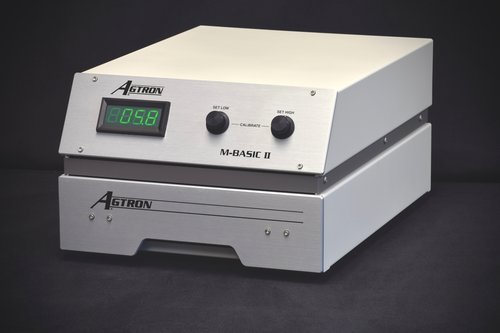Coffee Roast Color Analyzer by Agtron M-Basic-II
The M-Basic II from Agtron is a large area (26 sq.in.) reflectance spectrophotometer designed to deal with the challenge of measuring color and process-related changes associated with food and this large viewing area permits analysis of the irregular geometry of foods with little or NO sample preparation.
Four Color Reflectance Mode (red-yellow-green-blue)
Provides a single numerical score for each of the four colors simultaneously.
Single Color Reflectance Mode:
Displays one user-selected color as a single number score.
Appearance Mode
Uses the full visible spectrum and provides a single score calculated with human perception bias. This score relates to how the product generally appears to the consumer. A two-point change in score from product to product is noticeable under any common lighting condition.
Brightness Mode
Uses the full-color spectrum to determine the perceived lightness/darkness of a product. A one-point change in score is noticeable.
Ratio Mode
This is a special feature for determining the maturity of fresh tomato juice. It also accurately evaluates the degree of cook for tomato sauce and paste. Requires optional calibration disk and Petri dish adapter.
NOTE: All Agtron units now have auto-adjusting universal power supplies so they will function correctly on any voltage from 90-250 V, 50/60 Hz.
New Features:
Excellent Agreement with other M-BASIC II Analyzers
One of the design priorities of the M-BASIC II was to improve the analyzer to analyzer agreement within the M-BASIC II family and over indefinite periods. The results are an inter-instrument correlation of 0.30% and a long-term correlation of 0.50%. This is an order of magnitude improvement over previous MBASIC roast analyzers. A high level of inter-instrument agreement and confidence can be maintained even with analyzers in remote locations.
No More Fragile Glass Sample Dishes
The M-BASIC II joins the E20CP Roast Analyzer as a top-viewing instrument. It uses resilient plastic dishes, replacing the fragile glass type required by the bottom-viewing models. No sample dish cleaning is required from sample-to-sample tests.
Simplified Calibration
A two-point calibration method improves long-term control over both the analytical slope and span. In addition, improved stability requires less frequent calibration and takes only about one minute.
Super Durable Calibration Standards
The M-BASIC II features a new two-sided single calibration disk. Made from high strength plastic, this disk withstands the industrial environment, is stabilized for long-term accuracy and can be easily cleaned without damage.
Enclosed Shielded Sample
The sample is placed in a drawer that shields the product from ambient light during analysis eliminating potential environmental influence.
Improved Linearity
The M-BASIC II uses the same chemistry-based analysis strategy as all previous Agtron Roast Analyzers but roast scores now correlate more exactly to the sensory assessment of roast development. The M-Basic II has a correlation to the related compounds of 1.0%. The M-Basic that it replaces had a 3.0% correlation.
Improved Resolution
The M-BASIC II has a system resolution of 0.10%; extreme accuracy is inherent.
Faster Warm-up
The M-Basic II will take accurate readings 30 minutes after the analyzer is turned on. The previous M-BASICs required a 24-hour warm-up before use.
Solid State Long Life Lamps
The M-Basic II uses substrate-based solid-state NIR illumination eliminating the need to replace lamps. This new illumination features electronic regulation. As a result, the analyzer is extremely stable and impervious to line voltage fluctuation and transients. The design MTBF of the light source is 80,000 hours. When and if the light source does need replacement, it can be done easily in the field.
Super-Regulated Power Supply
The M-BASIC II has an all-new power supply. Electronic regulation allows the analyzer to function normally and accurately even in brown-out power line conditions. As an example, the 120 V/ 60 Hz version of the M-BASIC II will operate within specification at line voltages as low as 100 V or as high as 140 V and frequencies from 48 to 68 Hz. The analyzer is also well isolated and protected from the types of line voltage transients common to industrial environments that can cause damage to sensitive electronics.
Lower Power Consumption
The M-BASIC II uses about 28 watts, one-third the power of previous models.
Specifications:
- Analytical Methodology: NIR Absorption of Specific Wavelengths Associated with a Selected Compound Group Linearly Associated with the Thermal Development of Key Organic Coffee Constituents
- Selected Compound Correlation: +/- 1.0%
- Analytical Resolution: 1 Part in 1000 (0.10%)
- Dynamic Linearity: +/- 0.50%
- Dynamic Range: 00.0 100.0%
- Measurement Field: 5.0 Inch Diameter (128 mm), Circular
- Measurement Geometry: Incident to Sample
- Illumination Geometry: Incident to Sample, Diffused
- Inter-Instrument Agreement: +/- 0.30%
- Calibration Standard: Two-Sided Reflectance Disk, Stabilized Resilient Plastic
- Display: 3 Digit Back-Lit LCD (XXX.X)
- Illumination Source: Electronic Regulated NIR Emitting Solid-State Substrates
- Detection & Amplification: Silicon Photo Detector, Ultra-Low Noise Trans Conductance Amplification
- Optics: Fully Coated Glass
- Optical Filter: Three-Cavity Notch, Hard Coated
- Optical Geometry: Selected Field, Single-Plane Focus
- Power Requirement: Available Configured for 100, 120, 220 or 240 V 50/60 Hz, 28 Watts
- Dimensions: 14.50 Wide (368mm) / 9.50 High (242mm) / 20.25 Deep (515mm)
- Analyzer Weight: 27.5 Pounds (12.5 Kg)




